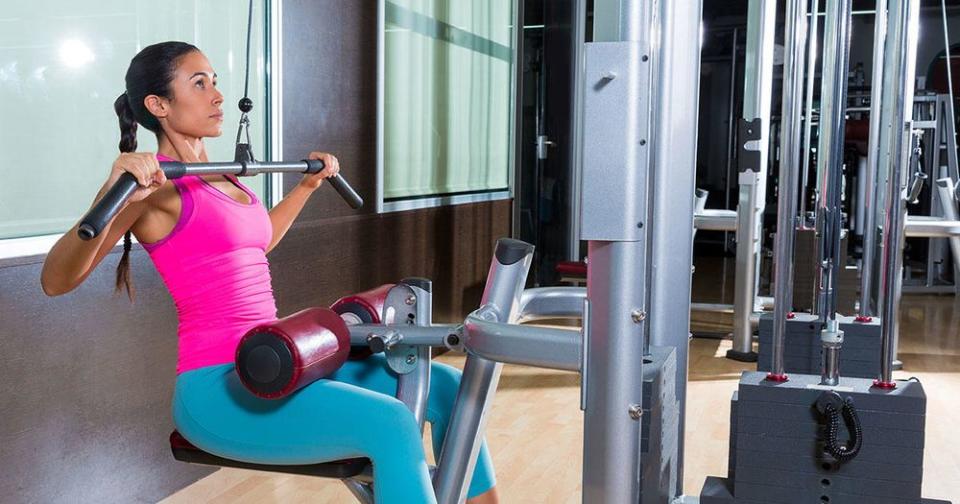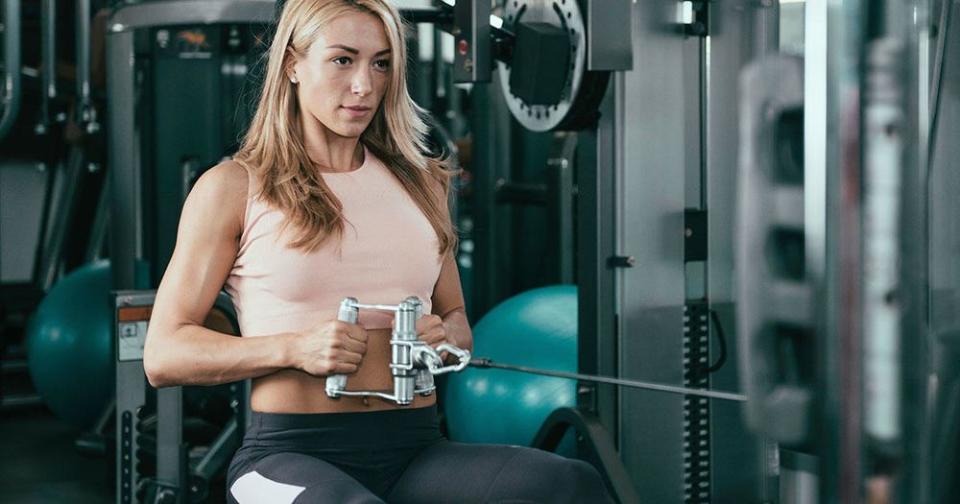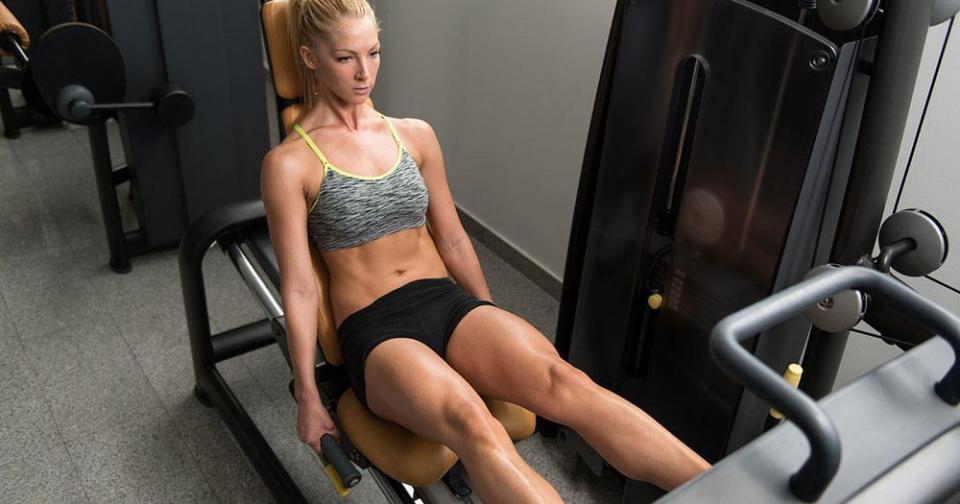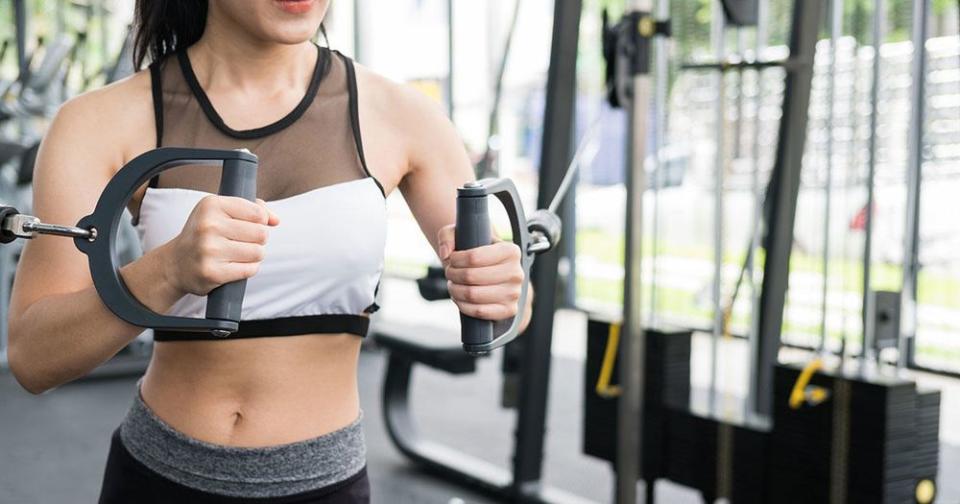7 Exercise Machines That Are Actually Worth Your Time

Photo: Tono Balaguer
When choosing how to best spend your minutes at the gym, experts generally give machines a hard pass in favor of bodyweight exercises or free weights. And it's not really shocking: Most of what we've learned about gym machines is that they suck.
"Exercise machines are, for the most part, used to work only one body part or muscle group at a time. And from everything we've learned about fitness, we know that that isn't the best use of your time," explains trainer David Carson, C.S.C.S., a Nike trainer and coach on the SweatWorking workout app. "In this fitness climate—where we're taught we need to do the most work or use the most body parts in the least amount of time—machines don't necessarily fit into the equation."
Since leg and arm machines at the gym are inherently stable and have one (or a few, at most) fixed motions, you're also not using supporting muscles to keep your body and the weight stable, adds trainer Laura Arndt, C.S.C.S., CEO of Matriarc, a pre- and postnatal fitness app. For example, doing a standing biceps curl will force you to engage your legs and core, whereas leaning over a biceps curl machine will keep most of the work in your upper body. (Related: How to Build the Perfect Circuit Training Workout)
And, while exercise machines may seem foolproof, you can still injure yourself if you use them incorrectly. "Machines require attention to detail when it comes to your chair settings and weight amounts. Using a machine in a repetitive motion on an inappropriate setting or with the wrong weight can cause injuries and damage your joints," she adds.
What's more, when using these leg and arm machines at the gym, you're spending a lot of time seated. If you perform a seated exercise and then spend your rest interval chillin' on your phone, your workout will end up being pretty inactive. (And isn't that the opposite of what you want to be doing during a workout?)
But before you're convinced to write off every workout machine at the gym, consider these seven gems that deserve some love—and a place in your workout routine.
1. Lat Pull-Down
A strong back will help you stand taller, reduce injury risk, and look seriously sexy in a strapless dress.
"You'll find a lat pull-down machine in every gym in America," says Carson. "This machine (indicated by its name) works the latissimus dorsi muscles (or lats) which are located on your back and wrap around the posterior of your ribcage," he says.
"What I love about the lat pull-down is how it simulates the pull-up, which is one of the best upper-body strength exercises you can do," he says. However, pull-ups are freaking hard—so it's unlikely that you can just whip one out without any training. Build up lat strength with one of the most effective arm machines at the gym, and you'll be nailing the perfect pull-up before you know it. "Everyone can stand to increase their pulling strength," says Carson. Try 3 sets of 8 to 12 reps.
2. Pull-Up/Dip Machine
Reminder: Pull-ups are tough, sure, but so are bodyweight dips. They're both killer for your upper body and back muscles and are much easier said than done. This combo machine allows you to work on both of them while reducing the percentage of your bodyweight that you're actually lifting, says Arndt. "This machine helps maintain good form as you build strength in your entire upper body, especially if you're a beginner or want to work on high-rep, low-weight sets," she says.
On an upper-body day, try using this machine for modified pull-ups and triceps dips. "I recommend using 50 to 70 percent of your bodyweight for 3 sets of 8 to 10 reps," she says. (Better yet, make it a superset by alternating between the two moves.)

Photo: Microgen / Shutterstock
3. Seated Row Machine
"Like the lat pull-down, the seated row machine works the lats, this time focusing more on the mid-back since you're pulling the weight toward you horizontally," says Carson. It also works the backs of your shoulders, biceps, and rhomboids (another back muscle). "This is a great move if you sit at a desk all day because that means you're likely losing strength in your postural muscles, which can cause pain and discomfort when weakened," he explains. Try 3 sets of 8 to 12 reps.
4. Chest Press
This exercise is an incredibly effective way to work several muscles at once.
"The chest press machine is a great way to isolate your anterior deltoids (the front of your shoulders) and pectorals (chest muscles) without putting too much strain on your wrists and shoulders like push-ups do," says Arndt. What's more, "if you have carpal tunnel or hand/wrist issues, a chest press machine is a great alternative to a bench press or push-up but works very similar muscle groups," she adds.
On an upper-body or chest/triceps lifting day, try 3 sets of 8 to 12 reps with a medium- to heavy-weight stack. (FYI, here's what a week of balanced workouts looks like.)

Photo: Jasminko Ibrakovic
5. Seated Leg Press
The leg press machine with back support offers a modified squat position, working your glutes, hamstrings, and quads without putting too much additional strain on your lower back and knees, says Arndt. "You can modify your chair setting to determine how 'deep' of a press/squat you want to do, and modify your weight as needed," she says.
"Because this exercise works big muscle groups—your glutes, hamstrings, and quads—it should be one of the first lower-body exercises you complete at the gym," she says. On a lower-body day, try 3 sets of 10 to 15 reps at a light- to medium-weight stack. Start light, and you can always go heavier if needed. (Hint: The last one or two reps should feel really hard.)
6. Hamstring Curl
"Hamstrings prove to be one of the most difficult muscles to isolate and work safely and effectively," says Carson. Yet, "the hamstring curl machine allows you to do both, which is invaluable for anyone who is new to resistance training or looking to increase strength and size of the hamstring," he says.
Because many women are naturally quad-dominant (meaning your quads are stronger than your hamstrings) it pays to incorporate moves that force your hamstrings to do all the work without letting your quads take over. (This is just one of several common muscular imbalances.) Incorporate hamstring curls into your workout to make sure the backs of your legs are feeling the love too. Try 3 sets of 8 to 12 reps.

Photo: psisa / GettyImages
7. Cable Machine
If you had to choose just one machine at the gym, use this one. That's because the cable tower—which features several weight stacks, adjustable cables, and a whole bunch of attachments—offers dozens of exercises to target all of your major muscles. With a mere flick of a clip, you can easily go from doing curls to kickbacks to rows. These multipurpose station even have some serious perks that free weights or bodyweight moves can't offer.
"Cable machines allow you to work in all angles, most of which can't be duplicated through dumbbells," he says. Because of gravity, you're always working against a downward pull with dumbbells or free weights. With a cable machine, you have the option to work against a horizontal or diagonal resistance.
And that's not all: Cable machines also offer a constant line of tension (which means weight stays uniform throughout the exercise)—again, not the case with dumbbells thanks to gravity, says Carson. Also, cable machines allow for many more movement patterns, offering more variability in the exercises you can do, he adds. Since you're able to fix the point of resistance up, down, and sideways, which you can't do on a seated arm machine at the gym, you can position your body in a variety of ways to work different muscle groups. You can stand, sit, kneel, pull, push, rotate—and effectively do a total-body workout on just this piece of equipment alone.
Not to mention, almost every move you do will force your core to stabilize against the pull of the cable, activating even more muscle groups on your body and helping you burn more calories and build functional strength. (Here's why it's so important to have a strong core.) It can also minimize injury. "By simply changing where the load is attached, cables can alleviate many of the overuse injuries that happen from dumbbells," says Carson. Try 3 sets of 8 to 12 reps of chest presses facing away from the machine for an upper-body and core move.
Avoid These Common Exercise Machine Mistakes
Don't forget to adjust the machines to fit your body. Keeping the seat too high or too low or placing your hands or feet in the wrong position not only makes the exercise less effective, but it can also put you at risk for injury.
Don't focus only on problem spots. Concentrating on just your butt, abs, or thighs and ignoring areas like your back, chest, or hips will make your body look imbalanced while also setting you up for injuries.
Don't work too hard. If your arms are so sore you can't hug your pillow, or if your quads ache for days going down a flight of stairs, it's time to back off and go with either fewer reps or less resistance. (BTW, here’s the right way to take a rest day.)
Don't do the same routine for more than a month at a time. Your muscles will be as bored as your mind—and you'll stop seeing results. Surprise your body by adding a new exercise at least every four weeks.

